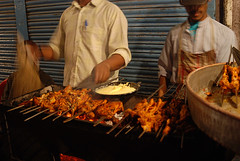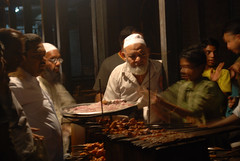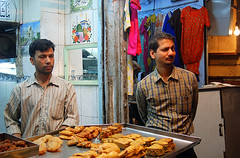The idea of a late evening walk originally came from food buff Monali, an Orkut friend who works for CSE (those obsessive warriors against pesti-colas). Last winter, we had taken a long walk through the bylanes of Old Delhi, sampling a variety of meaty and vegetarian fare dotted between Jama Masjid and Red Fort. Since another walk was long due and summers had arrived, Monali had suggested that we conjure one late evening stroll and turn it into a Hog Walk (her coinage). As luck would have it, Hemanshu popped up on my screen an evening later and floated an outing in Old Delhi. Things fell into place soon thereafter.
Friday the 13 (of April) had its effect: Monali, the originator of the idea, fell off the lane. To make up, Supriya and a firangi colleague of hers, Jason trudged along; Hemanshu, meanwhile, tricked Harneet and Shikha; and my wife Nidhi, after much cajoling, joined us as well. Thus, with these half-dozen humans, and three bottles of rum-laced pepsis, we set out for Urdu Bazaar-Matia Mahal food street.
Geography first: One would require to enter the Jama Masjid area from the Netaji Shubhash Marg red light to reach the ‘evening food stalls’ which appear as your cross Jagat cinema hall. Kababchis & barbeque artists are a majority in this lane, called Urdu Bazaar. A few paces down, the turn to your left is the Matia Mahal – Chitli Qabr street. This lane hosts hotels, restaurants, money-changers and other knick-knack shops. The traffic, human and vehicular, leaves limited scope for a fast pace; protruding bellies and a laidback lifestyle are ubiquitous.
We chose a roadside Tawa-Shami kababchi at Urdu Bazaar as our first host. A 300 wt bulb placed next to a wooden board introduced him as Bundu kababi, Bareillywalle no less. We ordered six shamis and one parantha for a setback of Rs 14 only. The kababs turned out too good to be divided among too many — but luckily, we had two grass-eaters in the group.
 The veggies were pushed to a phirni (cold rice pudding served in earthen saucers) stall nearby. A few steps and many a ‘pepsi’ swig later lay a chicken barbeque. The shiny morsels looked tempting and we stopped for the white meat this time. Another good decision. After roasting two skewers to perfection, the seller doused these pieces in pasteurized butter and — after pilfering a few slices — laid the fare before us. Well, if they could make a butter roast chicken so delectable, a little steal was the least of our bother. The damage was Rs 40/- but before someone compares it to the tava kababs, please note that buffalo meat is five times cheaper than chicks and lambs.
The veggies were pushed to a phirni (cold rice pudding served in earthen saucers) stall nearby. A few steps and many a ‘pepsi’ swig later lay a chicken barbeque. The shiny morsels looked tempting and we stopped for the white meat this time. Another good decision. After roasting two skewers to perfection, the seller doused these pieces in pasteurized butter and — after pilfering a few slices — laid the fare before us. Well, if they could make a butter roast chicken so delectable, a little steal was the least of our bother. The damage was Rs 40/- but before someone compares it to the tava kababs, please note that buffalo meat is five times cheaper than chicks and lambs.
 A below-average (by old delhi standards) experience came next when, while turning into the Matia Mahal street, we noticed a demanding crowd surrounding a fairly old guard supervising his boys roll seekh-kababs over coals. “Abbaji bana rahe hain toh koi baat zaroor hogi,” Hemanshu pitched for the grey flowing beard. Two plates of seekhs were duly ordered and we felt sorry for Abbaji shaming his years. The Kabas were a bit rubbery, at places burnt, instead of roasted, and without any punch. The only saving grace was the fair pricing (don’t embarrass me into mentioning it) which explained the crowd around the cart.
A below-average (by old delhi standards) experience came next when, while turning into the Matia Mahal street, we noticed a demanding crowd surrounding a fairly old guard supervising his boys roll seekh-kababs over coals. “Abbaji bana rahe hain toh koi baat zaroor hogi,” Hemanshu pitched for the grey flowing beard. Two plates of seekhs were duly ordered and we felt sorry for Abbaji shaming his years. The Kabas were a bit rubbery, at places burnt, instead of roasted, and without any punch. The only saving grace was the fair pricing (don’t embarrass me into mentioning it) which explained the crowd around the cart.
As we moved down the Matia Mahal street, Harneet, angling his Nikon, spotted what others could not. “Wahan sutli kabab ban rahe hain,” he piped in. For the uninitiated, Sutli or Dora Kababs are made of such marinated mince-meat that it melts in the mouth before you can say Jack Robinson. These kababs are actually so tender that to hold them to the skewer, a thin thread (sutli or dora), is wrapped around the raw paste. Once they are hauled over coal fire, and ready to serve, the dora/sutli is delicately pulled away and the kabab is left at the mercy of your fingers and tongue (no role of teeth here). No wonder, Harneet looked desperate. However, partly due to the dispersed company and mainly to the din all around, Harneet’s voice went unnoticed. Hemanshu, meanwhile, was busy asking the whereabouts of Kallu nihari wala, and would not give up even after being told that the shop shuts at 8 pm.
 This was the time when we noticed a fried fish stall lorded by two gentlemen wearing Shia caps and looking at our group with an amused expression. I ordered a plateful, about 300 grams of fish that is — smeared in besan paste and fried deep in unhygienic fat-rich oil. Ouch!! But as the unhealthy chunks with masala sprinkled on them, were passed around, there was all-round appreciation. “Yeh log kaun mulk se hain?” the Shia shopkeeper asked me with a deadpan face. “Sab Hindustani hain, maalik. Bas ek firangi hai,” I told him and he began to smile. I suspect it was a bulky pony-tailed Harneet, white-skinned Jason and the 5’9” tall and fair Supriya which triggered his confusion. Thank the Lord for gifting me an average height and colour.
This was the time when we noticed a fried fish stall lorded by two gentlemen wearing Shia caps and looking at our group with an amused expression. I ordered a plateful, about 300 grams of fish that is — smeared in besan paste and fried deep in unhygienic fat-rich oil. Ouch!! But as the unhealthy chunks with masala sprinkled on them, were passed around, there was all-round appreciation. “Yeh log kaun mulk se hain?” the Shia shopkeeper asked me with a deadpan face. “Sab Hindustani hain, maalik. Bas ek firangi hai,” I told him and he began to smile. I suspect it was a bulky pony-tailed Harneet, white-skinned Jason and the 5’9” tall and fair Supriya which triggered his confusion. Thank the Lord for gifting me an average height and colour.
Harneet was still stuck to sutli kababs and Hemanshu to Kallu Nihari. Neither succeeded. We realised that it was already past 11, and the only way to sate the veggies in particular, would be to begin a 300-metre retreat to Karim’s or Jawahar’s as soon as possible. We reached Karim’s in time and placed ourselves among a noisy clutter of china clay (Chinaware at Mughal dastarkhwan? Globalisation indeed had penetrated Old Delhi).
On order was chicken Jehangiri, mutton burra, seekh kababs and mutton “ishtu” for the carnivores and yellow dals & anda curry for the greenarians. So much has been written about Karim’s food that it would be sheer waste of energy describing it. However a few words about the staple of rotis and ishtu. The Kandhari roti, which is fluffed to perfection in the clay oven and is soft thanks to its special dough, and their seekhs have always been an object of admiration; inspite of the fact that the quality of the food has been down to half of what it was a decade back. Ishtu is mutton qorma with khada masala, which means the cloves, black pepper, green chilies and other numerable are not grounded and fried for the gravy. They are mostly put in as is, and animal fat or ghee is added later on. The best pieces are the ones which come with the bones. The closer to the cartilage and bone joint, the tastier and more nutritious the meat.
Topped up with cool phirni — the second in the day for the vegetarians — and we were ready to leave the old ramparts. Thankfully, our vehicles and their accessories were intact, due to a local dopey who doubled up as parking attendant in the late hours. Negotiating the crowds that we were part of, a few minutes earlier, we whistled out of the Jama Masjid area. A song was playing on my lips…
[photos courtesy Harneet Bhatia]
y dont u put up the fotos on orkut?
Amazing story. It’s these types of fly-by-the-seat-of-your-pants adventures that makes this such an a wonderful city and such a beautiful country.
Hi
It was interesting and informative to read your article…I’m a total foodie esp when it comes to street food. In the process of making a film on street food of Delhi with a deadline of five days!Any suggestions?
Aditi: why don’t you join us on our Chandni Chowk walk this Sunday (tomorrow)? See the calendar linked from the sidebar for details.
You can also drop me a mail at eatingoutindelhi [at] gmail.com if you want to discuss ideas.
Whole leg roasted to perfection at Karim’s. The Nargisi koftas are also great.
Hi…I used to read your website regularly earlier….but moving to mumbai the past few months, I had lost touch with ur foodie surfing….to my sadness i notice that there are no more posts since April 08 onwards….WHY??????
Pls do keep writing abt ur gastronomic adventures…i get a vicarious high. Also, I will be reaching Delhi for the puja hols on 4th October and wud be there the entire week….any possibility one or the other of you is planning a trip to jama masjid….i have never been there and wud luv to tag along…pls do mail me if u read this post…
Also can i cum along for the navratras food walk thats there in the calendar? I am mailing to ur gmail a/c also.
Pleaseeeee. Preety please….:)
I did my version of the hog-walk during a 5 hour stopover in Delhi on my way home – guided in large measure by inputs on this blog and Hemanshu’s google maps.
I took a Rickshaw from Chawri Bazaar to go to Aal Jawahar but stopped on the way when I found a ‘Daulat ki Chaat’ khomcha. It was really tasty but was disappointed that he was using refined (white ) sugar rather than bhoora. My 4-yr old loved it as well. When we reached Al Jawahar, they were finished with Nihari so I went to the adjacent jawahar hotel. Nihari was ok as long as you are willing to ignore that really tiny three pieces of meat. My son had the sooji-halwa which was very ordinary. Not satisfied, I came to Al Jawahar and asked for paya. While the gravy was tasty, the paya may as well have been chicken’s! I know it wasnt and the restaurant deserves the benefit of doubt as at 1030, I must have been served the last remnants. My son had the sheermal, and with all his life in Europe only description he could find was that they were really ‘nice, thick pancakes’ (sic)
On the way back we again had Daulat ki Chaat. I liked this version as compared to the ‘malai makkhan’ popular in Lucknow as no sugar is added to the malai which means that you can savour malai’s inherent sweetness. In Lucknow, they mix the mava/khoa and sugar in the malai-froth itself.
Well, I need to try some of the other recommended Nihari joints in Delhi…for now, with some embarassment, I must admit that the best Nihari I have had is at some Pakistani joints in London!
well my name is kabeer khan i m leave is choori walan delhi .6. And i love my old delhi bcoz pure india main old delhi jasi koi plase nahi haan i love jama masjid also..well guys plz come to old delhi And enjoy the foods bye tack care